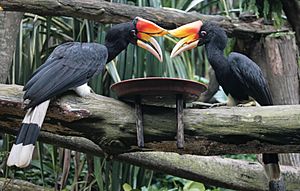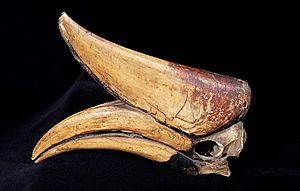Rhinoceros hornbill facts for kids
The rhinoceros hornbill (Buceros rhinoceros) is a very large forest bird. It is a type of hornbill and can live for up to 35 years in zoos. You can find these amazing birds in warm, wet rain forests up to 1,400 meters high. They live in places like Borneo, Sumatra, Java, the Malay Peninsula, Singapore, and southern Thailand.
Quick facts for kids Rhinoceros hornbill |
|
|---|---|
 |
|
| A pair in Singapore Zoo | |
| Conservation status | |
| Scientific classification | |
| Genus: |
Buceros
|
| Species: |
rhinoceros
|
The rhinoceros hornbill is a special bird in Malaysia. It is the state bird of Sarawak and the country's National Bird. Some Dayak people believe it is the most important bird in the world. They use statues of it to welcome a god named Sengalang Burong to their parties. This bird is even shown on the 5 Malaysian ringgit money bill!
Contents
Appearance of the Rhinoceros Hornbill
The rhinoceros hornbill is a big bird that lives in trees. It can be about 80 to 90 centimeters (about 31 to 35 inches) long. Male hornbills weigh around 2.5 to 3 kilograms (5.5 to 6.5 pounds). Females are a bit lighter, weighing about 2 to 2.3 kilograms (4.5 to 5 pounds).
Most of their feathers are black. They have white legs and a white tail with a black stripe. Their most striking feature is their huge, bright orange and red beak. This color comes from special oil they rub on it. Males have red eyes with black rings. Females have white eyes with red rings.
Rhinoceros Hornbill Behavior
What Rhinoceros Hornbills Eat
Rhinoceros hornbills mostly eat fruit. But they are not picky eaters! They will also catch and eat insects, small reptiles, tiny rodents, and even smaller birds if they can.
Rhinoceros Hornbill Reproduction
The way these hornbills find a mate and build trust is very important. This is because the female needs to trust the male completely. She relies on him to bring her all her food when she is nesting.
These birds build their nests inside hollow tree trunks. The female goes inside the tree cavity with her eggs. She stays there with the eggs and later with the baby chicks. The male's job is to bring food to her and the chicks.
After the female lays her eggs, the male collects mud. The pair then uses this mud, along with food and even their own waste, to seal up the entrance to the tree hole. They leave only a tiny opening. This small hole is just big enough for the male to pass food through. It also allows the female to get rid of waste.
Once the chicks have all their feathers and are big enough, the parents break open the dried mud. This lets the young hornbills finally leave their cozy tree nest.
Protecting the Rhinoceros Hornbill
The rhinoceros hornbill faces several dangers. One big problem is that their rainforest homes are being destroyed. People also hunt them for their meat, skulls, and feathers. When large trees are cut down, it's harder for these birds to find places to nest. This also makes it easier for hunters to find them.
Sometimes, poachers (illegal hunters) shoot rhinoceros hornbills by mistake. They confuse them with the helmeted hornbill, which is hunted a lot. Because of these threats, the rhinoceros hornbill's conservation status was changed in 2018. It is now considered a vulnerable species on the IUCN Red List. This means it is at high risk of becoming endangered.
Gallery
-
Male at the National Aviary, Pittsburgh. Males have red irises.
-
Female at Chester Zoo, England
-
Female at Birdworld, England
See also
 In Spanish: Cálao rinoceronte para niños
In Spanish: Cálao rinoceronte para niños











